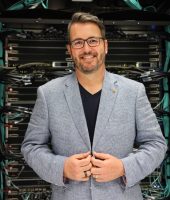On a cold, August morning, six Pawsey staff set off to Geraldton, a regional town over 400 kilometres away from Perth. With stars on their minds, the team were destined for the Murchison Radio Observatory (MRO) – a radio-silent zone a further 350 kilometres from Geraldton.
The MRO currently hosts two world-leading radio astronomy telescopes, the Australian SKA Pathfinder (ASKAP) and the Murchison Widefield Array (MWA).
These precursor telescopes are paving the way for Western Australia to host the Australian component of the international Square Kilometre Array (SKA) project.
Operated by the CSIRO, the MRO is ideally situated for listening to faint ‘whispers’ from space. Its low levels of radio-frequency interference and sophisticated on-site infrastructure enable an international group of researchers to explore the origins of the universe and map the vast night sky.
Pawsey’s morning started with a site safety induction followed by a cultural heritage induction. Led by CSIRO’s Leonie Boddington of the region’s Wajarri people, whose land the MRO is built upon.
“Gurlgamarnu yalyba, thana nganggurnmanha ilgarijirri”, Boddington explained – “lots of ear things they listening to what’s in the sky”.
Learning of the community’s spiritual and cultural connection to the land, language and history of the region set the tone for the group’s 2-day experience.
To have the full MRO experience, and build their connection with the land, the group set off on a four-hour drive to Boolardy Station – the place MRO calls home.
On the way, the team stopped to walk through data and communication huts, which housed various infrastructure which establishes optical connections between the MRO, Geraldton and Pawsey Supercomputing Centre. Seeing this while surrounded by the West Australian bush – red earth, rare wildflowers, emus, kangaroos and cattle – made the juxtaposition of the city and regional life more real.
It was humbling to see the communication highway in a remote land, that was part of the catalyst for the establishment of the Pawsey Supercomputing Centre.
The sun was beginning to set as the group arrived at the camp on Boolardy Station. A 4-building site with a group of accommodation dongas – solar powered and backed by diesel generators.
There was only enough time to drop off bags before heading to the SKA-low site – an uncleared area of land that will eventually host anywhere between 100,000 to a million antennaeeeeeeeee.
This array will enable research into an exciting period in our universe’s history – the formation of its first stars and galaxies. This gives valuable insight into dark matter, dark energy and the evolution of the universe.
The remoteness exposed them to an unadulterated night sky – thousands upon thousands of stars which surrounded the contrasting Milky Way cloud – something impossible to see in a light-polluted city.
After experiencing the endless night sky, the group eagerly went to bed, knowing soon they’d be on site with the instruments that are mapping what they just saw.
The Australian Square Kilometre Array Pathfinder (ASKAP) is a 36-dish telescope conducting groundbreaking research in technologies for the SKA to enable extensive sky surveys in great detail. These dishes have Wajarri names, given by Elders in the community.
The optical fibres the group saw on the way to site connect the sky with the land. The data collected by the telescope is transported to a specially designed control building that prevents electromagnetic interference from escaping. It has two layers of robust metal shielding and airlock doors designed to meet exacting international radio emissions standards.
It was inspiring for Pawsey to see the events that occur before researchers use supercomputers to process their data. The scale and complexity of the projects are massive. The project will have an output of 2 terabytes of raw data per second – the equivalent of filling 340,000 laptops per day!
This is where our specialists come in – Pawsey is working hard to get ready for the SKA project phases to go live. As the final part of the radio-astronomy data pipeline, Pawsey will process and store the data collected from the telescopes; enabling radio-astronomers all over the world to undertake groundbreaking research in the field.
As quickly as it began, the once-in-a-lifetime tour of the Murchison Radio Observatory drew to a close with Pawsey boarding an 8-person plane back to Geraldton.
It was a fast trip, but the team experienced a whole new world, gained valuable insights and context into major international collaborative projects, and connected with the sky and land of the traditional owners of the beautiful Wajarri region.

